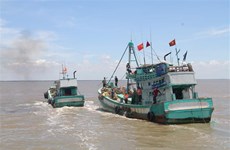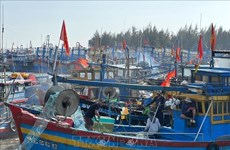Survey on wild animal product consumption released
The Wildlife At Risk (WAR) on May 23 announced the latest findings on
consumption of wild animal products in Ho Chi Minh City .
The Wildlife At Risk (WAR) on May 23 announced the latest findings on
consumption of wild animal products in Ho Chi Minh City .
These findings are results of a survey, which was carried out on 4,000 residents and nearly 3,600 secondary school students in Ho Chi Minh City from August 2010 to April 2011.
According to the survey, which was a joint effort of WAR and the Faculty of Biology, University of Science, Ho Chi Minh City National University, over half of the surveyed residents have used wild animal products, of which nearly 50 percent have consumed wild animal products more than three times per year. Men consume more wild animal products than women.
Food accounts for the greatest percentage of wild animal products consumed in Ho Chi Minh City , followed in turn by wild animal drinks, health products, pets, and fashion and ornamental purpose.
Restaurants in Ho Chi Minh City are the most common place for people to eat wild animal foods. The majority of Ho Chi Minh City people eat wild meat because others invite them, they want to try new experiences or they feel the meat is more delicious.
Middle-aged group (36-45 years old), government officers, and people with high education levels have a tendency to consume wild animal products more than other age groups, people with lower social working position, and people with lower education level.
The survey also shows that secondary school students in Ho Chi Minh City was strongly influenced by their parents and adults in their families in the consumption of wild animal products.
However, only 28.2 percent of surveyed students in Ho Chi Minh City have consumed wild animal products.
Not like the adults, students usually go to eat wild meat with their parents in specialty restaurants in other provinces or during family events such as birthdays and family gatherings at home.
Results of the survey on knowledge and attitude of the city’s residents and students reveal that all of them have good knowledge about the roles of wild animals but they do not understand well about the rarity levels of small wild animals that are mainly consumed. They do not know clearly about wild animal trade. They think that trading of any wild species is illegal. They think that consumption of wild animal products is the most dangerous threat to wild species.
In reality, wild animal product consumers are the force of illegal hunting and trading of wild animal products, helping push some wild animals to the brink of extinction.
Most of residents and students know the offices they could report to when they find out illegal wild animal trade. However, most of them do not know and do not remember the correct telephone number to report those crimes.
The surveyed students have a good attitude towards wild animal protection. They are also more willing to take part in wild animal protection than adults.
Based on results of this survey, WAR recommends that communication and education programs need to be designed and developed for both residents and students in order to prevent illegal wild animal consumption.
It also calls for strengthened law enforcement and more conservation research should be developed to contribute to wildlife protection, especially protection of threaten species./.
These findings are results of a survey, which was carried out on 4,000 residents and nearly 3,600 secondary school students in Ho Chi Minh City from August 2010 to April 2011.
According to the survey, which was a joint effort of WAR and the Faculty of Biology, University of Science, Ho Chi Minh City National University, over half of the surveyed residents have used wild animal products, of which nearly 50 percent have consumed wild animal products more than three times per year. Men consume more wild animal products than women.
Food accounts for the greatest percentage of wild animal products consumed in Ho Chi Minh City , followed in turn by wild animal drinks, health products, pets, and fashion and ornamental purpose.
Restaurants in Ho Chi Minh City are the most common place for people to eat wild animal foods. The majority of Ho Chi Minh City people eat wild meat because others invite them, they want to try new experiences or they feel the meat is more delicious.
Middle-aged group (36-45 years old), government officers, and people with high education levels have a tendency to consume wild animal products more than other age groups, people with lower social working position, and people with lower education level.
The survey also shows that secondary school students in Ho Chi Minh City was strongly influenced by their parents and adults in their families in the consumption of wild animal products.
However, only 28.2 percent of surveyed students in Ho Chi Minh City have consumed wild animal products.
Not like the adults, students usually go to eat wild meat with their parents in specialty restaurants in other provinces or during family events such as birthdays and family gatherings at home.
Results of the survey on knowledge and attitude of the city’s residents and students reveal that all of them have good knowledge about the roles of wild animals but they do not understand well about the rarity levels of small wild animals that are mainly consumed. They do not know clearly about wild animal trade. They think that trading of any wild species is illegal. They think that consumption of wild animal products is the most dangerous threat to wild species.
In reality, wild animal product consumers are the force of illegal hunting and trading of wild animal products, helping push some wild animals to the brink of extinction.
Most of residents and students know the offices they could report to when they find out illegal wild animal trade. However, most of them do not know and do not remember the correct telephone number to report those crimes.
The surveyed students have a good attitude towards wild animal protection. They are also more willing to take part in wild animal protection than adults.
Based on results of this survey, WAR recommends that communication and education programs need to be designed and developed for both residents and students in order to prevent illegal wild animal consumption.
It also calls for strengthened law enforcement and more conservation research should be developed to contribute to wildlife protection, especially protection of threaten species./.













